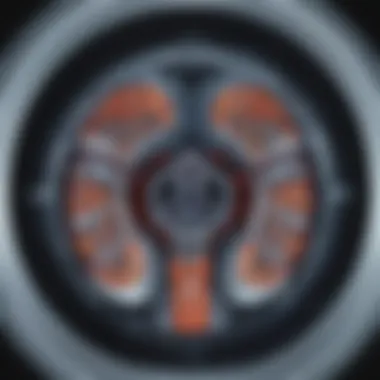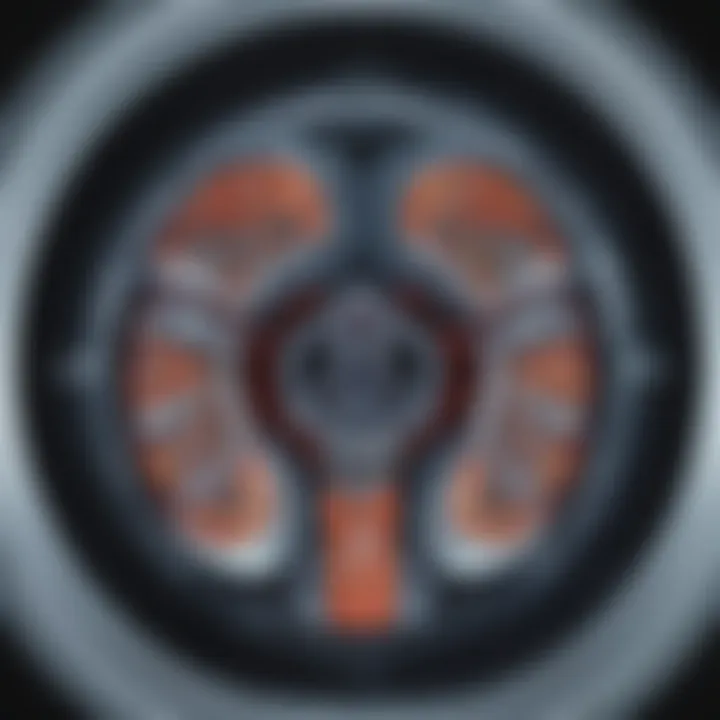Understanding Medical Scanning Machines: Advances and Applications


Intro
Medical scanning machines have fundamentally transformed the landscape of healthcare. These machines are not just tools for imaging; they are vital to understanding the complexities of human health. From magnetic resonance imaging (MRI) to computed tomography (CT), each technology serves a precise function. Advances in these machines continually push the boundaries of what is medically possible. As we delve into this topic, we will explore various types of scanning machines, their functionalities, and their impact on diagnostics and treatment.
Research Overview
Summary of Key Findings
This article explores how modern scanning machines improve the accuracy of medical assessments. Improved imaging techniques allow for clearer visibility of internal anatomy. With developments in artificial intelligence, the accuracy of image interpretation is also rising.
Additionally, the integration of scanning technologies in everyday medical practices enhances early disease detection. It can lead to better treatment planning and patient outcomes. Furthermore, considerations about the privacy and ethical implications surrounding patient data will also be discussed.
Importance of the Research
Understanding medical scanning machines is critical for various stakeholders. For healthcare professionals, staying updated on advanced imaging technologies can impact practice effectiveness. For patients, knowledge of how these machines work can alleviate anxieties related to diagnostic procedures. Research in this area ultimately shapes healthcare policies and resource allocation.
Methodology
Study Design
The research adopts a qualitative design. Emphasis is placed on reviewing existing literature on medical scanning technologies. Articles from peer-reviewed journals, textbooks, and reputable online resources have been critically assessed. The aim is to gather comprehensive insights about advancements and applications in medical scanning.
Data Collection Techniques
Data collection involves gathering information from multiple sources. These include:
- Academic journals related to medical technology
- Conferences and symposiums focused on imaging advancements
- Interviews with industry experts and healthcare professionals
By utilizing a diverse set of data, the aim is to ensure a multifaceted understanding of medical scanning technologies.
The advancements in medical scanning machines are transitioning healthcare from reactive measures to proactive prevention, thereby reshaping patient outcomes.
Preamble to Medical Scanning Machines
Medical scanning machines have revolutionized the way healthcare is delivered. Their ability to visualize the interior of the human body plays a crucial role in diagnostics, treatment planning, and monitoring. These advanced technologies aid healthcare professionals to make informed decisions, significantly enhancing the efficiency of medical examinations.
The importance of understanding medical scanning machines lies in their diverse applications and continual advancements. They have become an integral part of modern medicine, enabling non-invasive exploration of complex bodily systems. The intricate principles governing their operations are paramount for multiple stakeholders including students, researchers, and medical professionals. Each imaging modality brings unique strengths that contribute to a comprehensive approach in patient care.
Definition and Purpose
Medical scanning machines refer to a group of diagnostic tools that create images of internal body structures. These include Magnetic Resonance Imaging (MRI), Computed Tomography (CT), Ultrasound, Positron Emission Tomography (PET), and X-ray machines, among others. The primary purpose of these machines is to provide clear, precise images that help in detecting abnormalities such as tumors, fractures, and organ dysfunction.
The role of these machines is not limited to diagnosis. They also assist in treatment planning by giving insights into the location and nature of medical issues, and they are useful for real-time monitoring of disease progression or treatment effects. With their varied applications, they enhance the overall quality of healthcare delivery.
Historical Overview
The evolution of medical scanning technology reflects the broader advancements in medical science. X-rays, invented by Wilhelm Conrad Röntgen in 1895, represent the first breakthrough in medical imaging. This technology laid the groundwork for subsequent innovations.
Following the discovery of X-rays, CT scanning emerged in the 1970s, offering cross-sectional images of the body. This advancement enabled more detailed observations than traditional X-rays. The invention of MRI in the 1980s introduced another layer of complexity, allowing for even greater detail, especially in visualizing soft tissues.
In the following decades, the introduction of Positron Emission Tomography (PET) scanning brought functional imaging into the forefront, offering insights into metabolic processes of organs and tissues. Today, ultrasound technology has evolved significantly as well, becoming widely used in prenatal imaging and various diagnostic applications.
The continual development in this field is driven by growing needs for non-invasive procedures and real-time evaluation of patient health. As more advanced scanning technology emerges, understanding their evolution and functionality becomes increasingly important for effective application in healthcare.
Types of Medical Scanning Machines
Understanding the various types of medical scanning machines is crucial to appreciating their roles in modern healthcare. Each machine type employs unique technology to capture images of the body's internal structures, assisting in diagnosing and treating medical conditions. The ultimate purpose of these scanning techniques is to improve diagnostic accuracy, enabling better treatment planning and patient outcomes.
Magnetic Resonance Imaging (MRI)
Magnetic Resonance Imaging uses strong magnetic fields and radio waves to generate detailed images of organs and tissues. MRI is non-invasive and particularly useful for imaging soft tissues, such as the brain, muscles, and cartilage. An advantage of MRI is its ability to produce images in multiple planes, providing a comprehensive view of the area being examined. However, it is worth noting that patients with certain implants, such as pacemakers, may not be eligible for MRI due to the magnetic fields used.
Computed Tomography (CT)
Computed Tomography scanning utilizes X-rays to create cross-sectional images of the body. A CT scan combines multiple X-ray images taken from different angles and uses computer processing to create tomographic images. This technique is particularly effective in diagnosing conditions related to internal injuries and detecting cancers at early stages. One consideration with CT scans involves the radiation exposure; however, advancements in technology have aimed to reduce this risk significantly.
Ultrasound Imaging
Ultrasound imaging employs sound waves to produce images of structures within the body. It is widely used in obstetrics for monitoring fetal development and in assessing various organ systems. An advantage of ultrasound is its safety profile; it carries no radiation risk, making it suitable for frequent monitoring in certain patient populations. However, the clarity of images can be affected by factors such as patient obesity or air in the intestines.


Positron Emission Tomography (PET)
Positron Emission Tomography is a specialized imaging technique that helps visualize metabolic processes in the body. PET scans utilize radioactive tracers that emit positrons, which collide with electrons to produce gamma rays. This technique is invaluable in oncology since it provides critical insights into the functioning of tissues and organs, enhancing cancer diagnosis and treatment monitoring. Patients must be informed about the use of radioactive materials during the procedure, as it raises safety considerations.
X-ray Machines
X-ray machines are among the oldest forms of medical imaging technology. They use ionizing radiation to generate images of dense structures such as bones. X-rays are quick, relatively inexpensive, and widely available, making them essential in trauma settings. However, overuse of X-ray imaging is a concern due to cumulative radiation exposure. Health professionals must be aware of the risks and benefits when recommending such imaging.
"Each type of medical scanning machine plays a crucial role, offering distinct advantages while also presenting specific considerations."
In summary, the classification of medical scanning machines showcases their diversity and significance in healthcare. Each type contributes unique insights that can aid in diagnosis, treatment planning, and monitoring of various conditions.
Principles of Imaging Techniques
The principles of imaging techniques form the foundation of medical scanning machines and are crucial for their proper understanding. These principles explain how various scanning methods produce images of the body’s internal structures. In a clinical context, a deep understanding of these principles allows healthcare professionals to choose the most appropriate imaging technique based on patient specific needs, hence enhancing diagnostic accuracy. The implications of this knowledge are vast, as they can impact treatment protocols and patient outcomes.
How MRI Works
Magnetic Resonance Imaging (MRI) operates by using powerful magnets and radio waves to generate detailed images of organs and tissues within the body. When a patient is placed in an MRI scanner, the strong magnetic field aligns hydrogen nuclei within the body. Radiofrequency pulses are then applied, causing these nuclei to emit signals. The signals are captured and processed to create cross-sectional images.
An advantage of MRI is its high-resolution images, particularly beneficial for soft tissue analysis. It does not use ionizing radiation, making it safer for repeat studies. However, it can be time-consuming and sometimes uncomfortable for patients. Additionally, conditions like claustrophobia can pose challenges in certain cases.
CT Scan Mechanism
Computed Tomography (CT) scans utilize a series of X-ray images taken from different angles. A computer processes the images to create cross-sectional pictures of bones, blood vessels, and soft tissues.
CT has several benefits, such as speed and precision, making it an effective tool for emergency diagnoses. It is particularly useful for detecting internal bleeding, tumors, and other serious conditions. However, the exposure to ionizing radiation presents a risk, especially in repeated scans.
Ultrasound Technology
Ultrasound imaging works by sending high-frequency sound waves into the body. These sound waves bounce off internal structures, creating echoes that are transformed into images. This technique is widely used for monitoring pregnancies and examining soft tissues.
Ultrasound is advantageous due to its non-invasive nature and minimal risks involved. Unlike other imaging techniques, it does not involve radiation, making it safer for frequent use. However, image clarity can be affected by factors like patient obesity or gas in the intestines which may hinder the sound waves.
PET Scan Functionality
Positron Emission Tomography (PET) scans involve the injection of a radioactive tracer, which emits positrons. When these positrons collide with electrons in the body, gamma rays are released, detected by the scanner to produce images. PET scans are particularly useful for identifying cancer, as cancerous cells often show higher levels of activity and therefore absorb more tracer.
The primary strength of PET scans is their ability to provide metabolic information, making them distinct from other imaging techniques. However, the use of radioactive materials raises concerns regarding safety and potential side effects, despite the doses being relatively low.
X-ray Imaging Process
X-ray imaging is one of the oldest forms of medical imaging. It operates by passing X-rays through the body, where denser structures like bones absorb more rays, creating dark and light areas on the resulting film.
The advantages of X-ray imaging include its speed, low cost, and effectiveness in assessing fractures. However, it does involve exposure to ionizing radiation, which necessitates careful consideration, especially among vulnerable populations such as pregnant women.
Important Note: Each imaging technique has its unique advantages and limitations. Understanding how these techniques work is critical for medical professionals to make informed decisions and ensure patient safety.
Advancements in Medical Scanning Technology
Advancements in medical scanning technology are pivotal in transforming the landscape of healthcare diagnostics. As technology progresses, enhancements in imaging techniques provide clinicians with better tools for diagnosis and treatment planning. These developments not only improve the quality of images but also increase the efficiency and speed of the scanning processes. By integrating modern methodologies, healthcare professionals can offer higher precision in measurements and analysis, essential for better patient outcomes.
The Role of Artificial Intelligence
Artificial Intelligence (AI) is reshaping the processes of medical imaging. In recent years, AI algorithms are trained to analyze vast amounts of imaging data, detecting patterns that may escape human eyes. This capability reduces the time needed for image analysis, allowing radiologists to focus more on treatment rather than just interpretation. By utilizing machine learning, AI can learn from thousands of scans, leading to improved diagnostic accuracy.
Moreover, AI systems are increasingly being integrated into imaging devices. This leads to enhanced features like real-time decision support. For example, if an AI system detects an anomaly in a scan, it can alert the physician immediately, facilitating timely intervention.
3D Imaging and Reconstruction
3D imaging technology represents a significant leap in the depth and detail of the scans produced. Traditional 2D scans can sometimes fail to present a comprehensive view of complex structures in the body. With 3D imaging, healthcare providers can visualize organs and tissues from multiple angles, offering a more complete picture. This technology aids in better surgical planning and can improve outcomes in fields like oncology and orthopedics.
Additionally, 3D reconstruction allows doctors to simulate interventions before performing actual procedures. Such simulations provide immense advantages in preparation and execution, particularly in minimal invasive surgeries.
Enhanced Resolution and Speed
The clarity of images produced by scanning machines directly affects the diagnostic process. Recent advancements in scanning technologies have led to enhanced resolution, enabling the detection of smaller lesions and abnormalities. Higher-resolution images result in more accurate diagnostics, crucial in critical medical scenarios. This ensures that conditions are identified in the earliest stages, significantly impacting treatment outcomes.
Speed is another critical factor. Faster scanning times decrease patient discomfort and allow for an increased patient turnover in clinics. This improvement is particularly essential in emergency contexts, where time is of the essence.
Portable Scanning Devices


Portable scanning devices are becoming more common in the medical field. These devices offer flexibility and accessibility for healthcare professionals. For instance, handheld ultrasound devices can be utilized in various environments, from emergency rooms to remote areas. Such tools provide immediate imaging results, which can be vital for timely diagnoses.
Moreover, portable devices are designed for easy transport and quick setup. Their user-friendly interfaces enable a broader range of healthcare workers, beyond specialized radiologists, to obtain essential images.
Advances in medical scanning technology not only enhance the quality of care but also democratize access to diagnostic services, bridging significant gaps in health equity.
Impact on Medical Diagnosis
Medical scanning machines have transformed the landscape of healthcare, revolutionizing the way diagnoses are made. They provide critical insights into the state of a patient's health through non-invasive means, significantly impacting medical diagnosis in several pivotal ways. Understanding this impact starts with recognizing the advancements these machines enable in terms of precision, timely information, and informed treatment plans.
As healthcare continuously evolves, the role of technology in diagnostics becomes increasingly integral. Modern imaging techniques aid not only in confirming suspicions but also in uncovering unexpected conditions. By enhancing the quality of assessments, medical scanning machines contribute to better patient outcomes and streamlined processes within healthcare systems.
Precision in Diagnoses
Precision is an essential component of effective healthcare. Medical scanning technologies, such as MRI and CT scans, allow for high-resolution imaging of internal structures. This capability diminishes the likelihood of misdiagnoses by providing clearer visual data on potentially pathological conditions that may not be visible through traditional examination methods.
Moreover, increased precision in imaging supports the identification of diseases at earlier stages. Conditions such as tumors, which benefit from early detection, can be diagnosed with higher accuracy and clarity. Consequently, this allows healthcare professionals to adopt a more targeted approach to treatment, improving overall patient management.
The specificity of images can also aid in distinguishing between different conditions that may present similar symptoms. For example, a CT scan can help differentiate between benign and malignant lesions, which is critical for determining an appropriate treatment strategy. This level of detail is invaluable, particularly in oncology where treatment timelines can significantly affect prognosis.
Real-time Monitoring
Another significant enhancement in medical diagnosis through scanning machines is the capability of real-time monitoring. This feature enables continuous observation of a patient’s condition without requiring invasive procedures. Technologies such as ultrasound exemplify this benefit; they allow doctors to visualize organ function or assess blood flow patterns dynamically during a procedure.
Real-time data acquisition provides doctors with immediate feedback, which is crucial in acute care settings. This capability improves decision-making speed, ensuring timely interventions. For patients undergoing treatment, real-time monitoring can also help in assessing the efficacy of specific therapies, thus informing clinical decisions as the treatment progresses.
The advantage of monitoring a patient's condition in real time extends to post-operative care as well. It allows for the identification of any complications that could arise following surgery, thus facilitating prompt responses to mitigate risks.
Treatment Planning
Medical scanning machines also significantly contribute to treatment planning by offering detailed insights into the exact nature of health issues. Knowledge gained from imaging studies equips healthcare providers with essential data needed to design customized treatment plans tailored to the individual patient’s needs.
For instance, in surgical planning, detailed imaging can assist surgeons in determining optimal approaches, potentially reducing surgery duration and improving outcomes. Similarly, in the context of radiation therapy, precise imaging ensures that targeted areas are accurately identified, minimizing collateral damage to healthy tissues.
In a broader sense, detailed imaging enhances collaborative efforts among multidisciplinary teams, allowing specialists, radiologists, and surgeons to review findings together. Such collaboration fosters a comprehensive understanding of a patient’s condition and facilitates the creation of holistic treatment strategies, ultimately leading to improved patient care.
"The integration of advanced imaging techniques into medical diagnostics is not only enhancing the precision of our work but also significantly improving patient outcomes."
Challenges in Implementation
Implementing advanced medical scanning machines presents several challenges that significantly affect how these technologies are integrated into healthcare settings. Understanding these challenges is crucial for optimizing the use of scanning technologies, ensuring patient safety, maintaining operational efficiency, and maximizing the overall benefits for healthcare systems. The following subsections delve into the specific difficulties encountered during the implementation of medical scanning machines and highlight the importance of addressing these issues for future advancements.
Cost and Accessibility
The financial aspect of deploying medical scanning machines is often the most daunting challenge. High costs of equipment and maintenance place a significant burden on healthcare facilities, particularly in lower-resourced settings. Procurement of machines like MRI or CT scanners involves not just the initial purchase cost but also recurring expenses, including servicing and staff training. This can limit accessibility, particularly in rural or underprivileged areas, where access to cutting-edge technology might be significantly restricted.
- The high price of sophisticated imaging machines can lead to:
- Reduced availability in certain regions.
- Increased waiting times for patients requiring scans.
- Alternative treatment options that may be less effective.
Investing in less expensive or refurbished machines may be an answer, but it can come with trade-offs in performance or reliability.
Patient Safety and Risks
Patient safety is paramount when implementing medical scanning technologies. Each type of machine carries unique risks. For example, while MRI does not use ionizing radiation, it requires patients to lie in a magnetic field, which may cause discomfort or anxiety. On the other hand, CT scans involve radiation exposure, which, if used excessively, may increase the risk of cancer over time.
Moreover, potential incidents such as equipment malfunction or improper operating procedures can pose a risk to patient safety. Successful implementation relies on:
- Strict adherence to safety protocols.
- Regular equipment maintenance to ensure optimal function.
- Continuous monitoring of patient experiences during scans.
Training and Expertise Requirements
The sophisticated nature of medical scanning machines necessitates that personnel be adequately trained to operate them. Training goes beyond understanding operation mechanics; it involves learning safety procedures, interpreting scan results, and managing patient interactions.
- Effective training programs must:
- Equip operators with technical skills.
- Foster a deep understanding of imaging principles.
- Emphasize patient care and comfort during scanning procedures.
Healthcare facilities often face challenges in assuring their staff are skilled enough. This can lead to longer onboarding times, increased operational costs, and a potential delay in patient care. Institutions must invest in regular training sessions to keep up with technological advancements and ensure that personnel are competent in using the latest machines.


"In many cases, successful scanning machine implementation directly correlates with the training and preparedness of healthcare providers."
By addressing these challenges, healthcare systems can enhance the efficiency of medical scanning machine operations, improve patient outcomes, and ultimately provide a higher standard of medical care.
Ethical Considerations
The integration of medical scanning machines into healthcare systems raises various ethical concerns that demand attention. These concerns often stem from the technologies' impact on patient rights, privacy, and equitable access to care. Addressing these concerns is essential for maintaining trust and integrity within the healthcare system. Each of the following ethical considerations plays a pivotal role in shaping how medical imaging technologies are perceived and utilized.
Informed Consent
Informed consent stands as a foundational principle in medical ethics. It ensures patients are fully aware of the procedures they will undergo, including risks and benefits associated with medical scanning. Patients should be provided with clear descriptions of how a specific scanning machine works and the type of information it will yield. This process is not simply about signature but also about empowering patients to make knowledgeable decisions about their own health.
Clear communication about what a scan entails, how it may affect treatment, and potential risks involved is crucial. For instance, patients undergoing a CT scan must understand the exposure to radiation. This respects the autonomy of patients while honing the transparency of the healthcare provider's intentions.
Data Privacy and Security
With the advancement of medical scanning technology, concerns regarding data privacy and security become increasingly significant. These machines often generate and store vast amounts of sensitive patient information. Therefore, stringent measures must be in place to safeguard this data against unauthorized access and potential breaches.
Healthcare providers require robust policies around data handling to ensure compliance with regulations like HIPAA in the United States. Continuous education and training for those handling this data are essential in preventing inadvertent leaks and ensuring that privacy is prioritized. Failing to protect patient information can lead to not only financial repercussions but also loss of patients' trust in healthcare systems.
Equity in Healthcare Access
Another paramount ethical consideration in the field of medical scanning technologies is equity in healthcare access. There exists a significant disparity in the availability of advanced medical imaging technologies across different geographical regions and socioeconomic groups. Patients in urban areas typically have easier access to superior healthcare resources compared to those in rural settings.
This inequality raises questions about fairness in healthcare delivery. Policymakers and healthcare administrators must work to ensure that the benefits of medical scanning machines extend to all segments of the population. Addressing these inequities involves not only investing in infrastructure but also developing policies that ensure affordable access to these essential diagnostic technologies. As medical imaging advances, striving for equitable access becomes increasingly crucial.
Ensuring ethical considerations in medical scanning technologies is not just about compliance; it's about fostering a healthcare environment where every individual feels valued and secure.
In summary, addressing the ethical considerations of informed consent, data privacy, and equity in healthcare access is of utmost importance. These principles ensure that medical scanning technologies are implemented in a manner that respects patient rights, prioritizes their data security, and promotes equitable healthcare access.
Future Directions in Medical Imaging
Future directions in medical imaging encompass a variety of new technologies, methods, and philosophies that hold the promise to revolutionize how healthcare is delivered. The importance of this topic cannot be understated as it intersects with the ongoing evolution of medical science, patient care, and ethical considerations.
Emerging advancements refine imaging quality, reduce time for diagnostics, and enhance overall patient experiences. Furthermore, the integration of imaging systems with other medical technologies creates more comprehensive health management solutions. This transformative phase signifies a shift towards personalized medicine, focusing on treatments tailored to individual patient needs and conditions.
Emerging Technologies
Emerging technologies are at the forefront of medical imaging innovation. Techniques such as advanced nuclear imaging and innovative software algorithms are improving diagnostic accuracy. A notable example includes the development of hybrid imaging systems, like PET/CT or PET/MRI, which allow physicians to obtain both functional and anatomical images simultaneously, thus offering a more complete view of a patient's condition.
Moreover, technologies like Augmented Reality (AR) and Virtual Reality (VR) are gaining traction in medical training and surgical planning. These tools help in visualizing complex anatomical structures, providing an immersive experience for healthcare professionals and ensuring better preparedness during procedures.
Integration with Other Medical Technologies
Integration with other medical technologies also paves the way for enhanced diagnostic and treatment processes. For instance, the collaboration between medical imaging machines and electronic health records (EHR) systems bolsters holistic patient management. By syncing imaging results with patient history, healthcare providers can make more informed decisions regarding treatments.
In addition, the use of cloud computing in medical imaging facilitates easier storage, access, and sharing of patient data among healthcare professionals. This enables timely discussions and consultations, leading to better patient outcomes.
Personalized Medicine
Personalized medicine adapts imaging techniques to the unique genetic and physiological profiles of patients. Advances in genomics are contributing significantly to this effort. Medical imaging often helps in identifying specific tumor markers or abnormalities that align with a patient’s genetic information.
This approach not only enhances diagnosis precision but also significantly influences treatment plans. Physicians can select targeted therapies that are most effective for individual patients, optimizing outcomes and reducing unnecessary side effects. The combination of personalized medicine and advanced imaging techniques represents a promising future in aligning patient care with unique health profiles.
As technology evolves, medical imaging continues to play a pivotal role in healthcare, with the potential to improve diagnostic accuracy and treatment effectiveness.
The End
The conclusion of this article synthesizes the essential insights gained from exploring medical scanning machines. These devices are not only pivotal in modern medicine but also represent the interplay of technology with healthcare. The advancements in imaging techniques have revolutionized the way healthcare professionals diagnose and treat patients.
One significant takeaway is that medical scanning machines, such as MRI, CT, and PET, enhance the accuracy of diagnoses. They provide high-resolution images, allowing for better assessments of various medical conditions. Patients benefit as a result, leading to quicker and more effective treatment plans.
Furthermore, the integration of artificial intelligence into imaging technology present prospects for even greater precision and efficiency. This embrace of technology assists in real-time data analysis, benefiting both healthcare providers and patients. The implications of improved diagnostics can be profound, potentially saving lives through early detection.
However, it is crucial to consider the ethical aspects and challenges surrounding the implementation of these technologies. Issues such as data privacy, consent, and equitable access must be addressed to ensure that advancements do not exacerbate existing disparities in healthcare.
In essence, the concluding segment of this article emphasizes that continued research and innovation in medical scanning technologies are vital. They hold the potential to transform patient care and health outcomes worldwide.
Summary of Key Insights
- Medical scanning machines are integral to modern healthcare.
- Enhanced imaging techniques improve diagnostic accuracy significantly.
- Artificial intelligence is transforming data analysis and imaging.
- Ethical challenges must be managed to ensure equitable healthcare access.
- Ongoing innovation is essential for improving patient outcomes.
The Future of Medical Scanning
Looking ahead, the future of medical scanning technologies seems promising. Several emerging trends suggest a pathway toward more efficient, accurate, and accessible medical imaging.
- Innovations in Imaging Techniques: New technologies are expected to enhance image quality and reduce exposure risks for patients.
- Integration with Other Medical Technologies: There is potential for combining medical scanning with other technologies, such as telemedicine and wearable devices, which could enable remote diagnosis and monitoring.
- Personalized Medicine: As understanding of genetics and individual patient profiles advances, imaging technologies will likely be tailored to meet the needs of specific patient populations, leading to more personalized treatment regimens.



